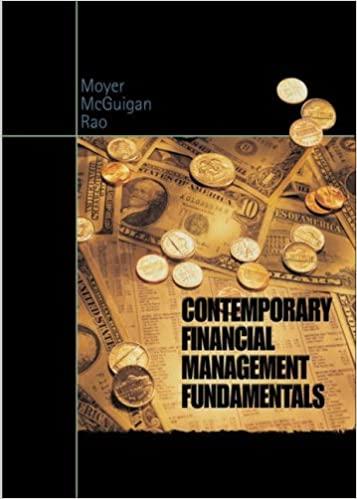Answered step by step
Verified Expert Solution
Question
1 Approved Answer
3. Solve the following problems: i. Use equations or the tabular approach to find the following values. You may check your answers using a financial
3. Solve the following problems:
i. Use equations or the tabular approach to find the following values. You may check your answers using a financial calculator. Disregard rounding differences.
a. An initial $500 compounded for 1 year at 6%
b. An initial $500 compounded for 2 years at 6%
c. The present value of $500 due in 1 year at a discount rate of 6%
d. The present value of $500 due in 2 years at a discount rate of 6%
ii. Use equations or the tabular approach (and a financial calculator to check your answers) to find the following values.
a. An initial $500 compounded for 10 years at 6%
b. An initial $500 compounded for 10 years at 12%
c. The present value of $500 due in 10 years at a discount rate of 6%
d. The present value of $500 due in 10 years at a discount rate of 12%
iii. Find the future value of the following annuities. The first payment in these annuities is made at the end of Year 1.
a. $400 per year for 10 years at 10%
b. $200 per year for 5 years at 5%
c. $400 per year for 5 years at 0%
d. Now rework parts a, b, and c assuming that payments are made at the beginning of the year.
iiii. Find the present value of the following ordinary annuities.
a. $400 per year for 10 years at 10%
b. $200 per year for 5 years at 5%
c. $400 per year for 5 years at 0%
d. Now rework parts a, b, and c assuming that payments are made at the beginning of the year.
v. Find the amount to which $500 will grow under each of the following conditions.
a. 12% compounded annually for 5 years
b. 12% compounded semiannually for 5 years
c. 12% compounded quarterly for 5 years
d. 12% compounded monthly for 5 years
vi. Find the present value of $500 due in the future under each of the following conditions.
a. 12% nominal rate, semiannual compounding, discounted back 5 years
b. 12% nominal rate, quarterly compounding, discounted back 5 years
c. 12% nominal rate, monthly compounding, discounted back 1 years
vii. Find the future values of the following ordinary annuities
a. FV of $400 each 6 months for 5 years at a nominal rate of 12%, compounded semiannually
b. FV of $200 each 3 months for 5 years at a nominal rate of 12%, compounded quarterly
c. The annuities described in parts a and b have the same total amount of money paid into them during the 5-year period, and both earn interest at the same nominal rate, yet the annuity in part b earns $101.75 more than the one in part a over the 5 years. Why does this occur?
viii. What is the present value of a perpetuity of $100 per year if the appropriate discount rate is 7%? If interest rates in general were to double and the appropriate discount rate rose to 14%, what would happen to the present value of the perpetuity?
ix. Ralph Renner just borrowed $30,000 to pay for a new sports car. He took out a 60-month loan and his car payments are $761.80 per month. What is the effective annual rate (EAR) on Ralphs loan?
x. Joe Ferros uncle is going to give him $250 a month for the next two years starting today. If Joe banks every payment in an account paying 6% compounded monthly, how much will he have at the end of three years?
Step by Step Solution
There are 3 Steps involved in it
Step: 1

Get Instant Access to Expert-Tailored Solutions
See step-by-step solutions with expert insights and AI powered tools for academic success
Step: 2

Step: 3

Ace Your Homework with AI
Get the answers you need in no time with our AI-driven, step-by-step assistance
Get Started


